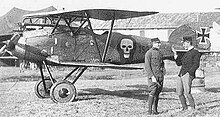Fighter pilot
Fighter pilot is the name of fighter pilots whose tasks in aerial warfare are to monitor the airspace and conduct aerial combat . They are pilots of fighter planes .
conditions
The requirements for fighter pilots have always been somewhat higher than those for pilots of other military aircraft. Mastering air combat maneuvers requires great flying skill. The high maneuverability of fighter aircraft means that significantly higher g-forces occur when in use than in other machines, which in turn causes greater physical stress on the occupants. Fighter pilots are specially trained for these conditions when flying powerful military aircraft. To protect against blood loss in the head - due to the heavy cornering load of up to nine times the acceleration of gravity - the pilots wear special pressure suits , known as anti-g suits . These build up counter pressure around the pilot's legs and abdomen to prevent the blood from sinking and resulting in unconsciousness. This is supported in modern fighter aircraft by a flat sitting position with seats tilted backwards between 20 and 37 degrees and legs high.

history
Many of the early aviation pioneers who had contributed to the development of aviation before the First World War , such as Adolphe Pégoud or Roland Garros , became fighter pilots during the First World War. Particularly successful in air combat pilots became aces hyped.
The training of a military pilot required 250 to 400 flight hours in World War II. In the German Air Force , this number fell to around 120 hours due to a lack of pilots, the Allied air superiority and towards the end of the war also due to the lack of jet fuel. The quality of the training of fighter pilots suffered, for example, due to the elimination of blind flight training .
It was not until the 1960s that a second crew member was often added due to the increasing complexity resulting from the introduction of on-board radar as a weather-independent sighting device and guided missile armament. Older heavy fighter aircraft with more than one man crew, such as the Messerschmitt Bf 110 , had proven to be less successful in daytime hunting , primarily because of their poorer maneuverability compared to small single-seaters.

